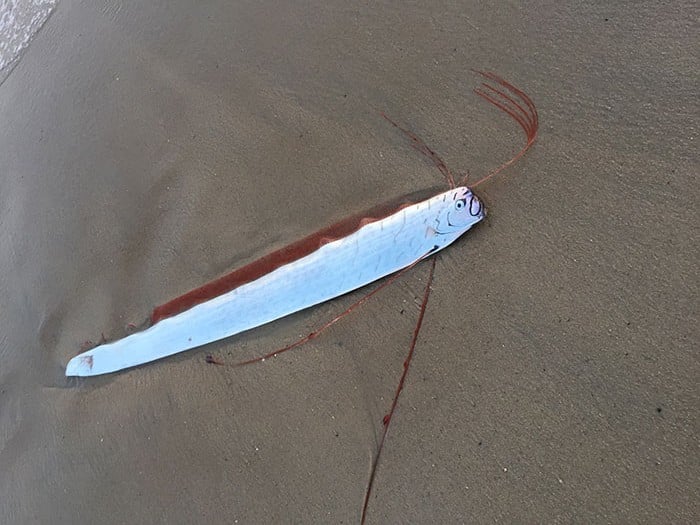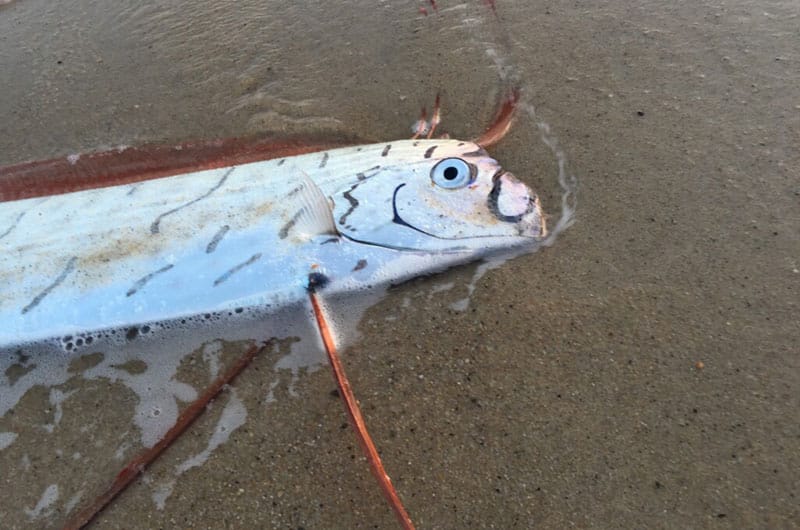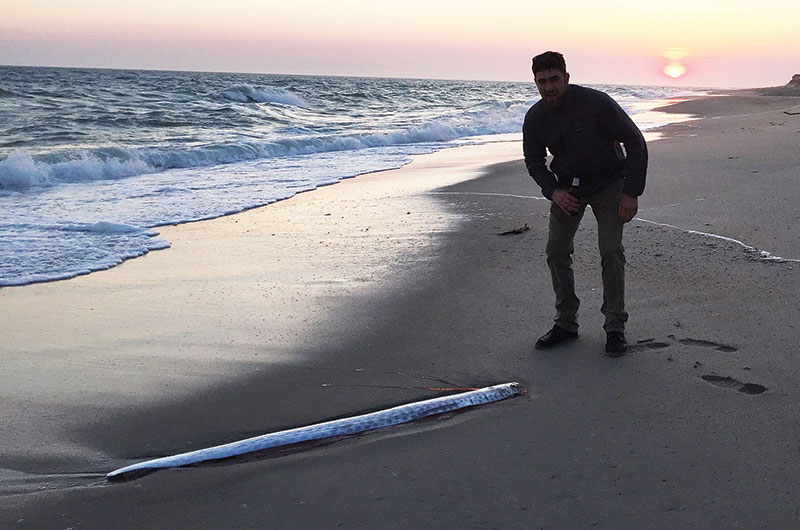• by Dr. Sarah D. Oktay, Director, University of Massachusetts Nantucket Field Station •

Two photos accompany this article and they may look like an elaborate gimmick or hoax but they are photos taken by Tyler Bradbury and Mike Strazzula of a giant oar fish that washed up on Nantucket Monday May 4th. They were out in Madaket enjoying the sunset on a warm spring evening when they saw this giant white thing flapping in the surf. What they were looking at was a rare oarfish (Regalecus glesne Ascanius), the longest bony fish in the ocean. Also known as King of the Herrings, oarfish have long ribbon-like bodies that can grow up to 50 feet in length. The fish is found worldwide, but is most common in cooler waters at latitudes greater than 15° and in the Eastern Atlantic Ocean and the Mediterranean Sea. It normally ranges as deep in the ocean as 3000 feet but they occasionally venture into shallower waters especially after storms. Its scaleless body is covered with a silver to silvery blue skin and is topped with an ornate, red dorsal fin that resembles a decorative headdress. This dorsal fin runs the entire length of the fish, with a tiny spine projecting above each of over 400 individual fin rays. The pelvic fins of this fish are elongated and similarly colored. The oarfish has a small mouth with no visible teeth. Their diet consists mainly of plankton, small crustaceans, and small squid that they strain from the water using specially formed gill rakes in their mouth. In turn, the oarfish may be a food source for larger ocean carnivores such as sharks (http://www.seasky.org/deep-sea/oarfish.html). This video shows what they look like swimming in the water https://www.youtube.com/watch?v=yK2g4Nwdxco . They normally stay in very deep water and rarely venture near shore. They were first described in 1772. The genus name “Regalecus” is from the Latin, regalis for “belonging to a king”.
“Underwater footage shows them slowly swimming vertically, head up, with a stiff body, only undulating the dorsal fin, and with photophores on their appendages. The mouth can be protruded for capturing prey. Large adults sometimes kill themselves by swimming out of the water onto beaches; occurrence of such strandings may be linked to certain areas, seasons or months and often in spates.” (from a very comprehensive article found at http://www.fishbase.org/summary/3267 and accessed on May 14 2015).
This deep sea video http://www.livescience.com/37314-rov-encounters-a-bizarre-deep-sea-oarfish-video.html shows the oarfish swimming at its regular depth. The dorsal fin does most of the work, undulating quickly in both directions to propel the creature who keeps the rest of its body relatively rigid in deep waters while feeding with the large reddish “antennae” sensory rays deployed above and below. In 2001, divers inspecting a navy buoy in the Bahamas were the first to videotape a five-foot oarfish in the water. They observed the oarfish swimming by undulating its long dorsal fin while keeping its body fairly straight. I sincerely wish I could do that; I swim by fighting the water with less grace and panache than the average house cat. This oarfish style of elegant propulsion is known as an amiiform (undulatory like a cuttlefish or squid) mode of swimming. Oarfish have also been observed swimming in a vertical position opening and closing its mouth as it forages for food.

“Little is known about the reproductive habits of the oarfish, although they have been observed spawning off the coast of Mexico between July and December. After spawning, the eggs are abandoned by the adults to float on the ocean surface until hatching. Once hatched, the tiny larvae feed mainly on plankton until they mature. Adult oarfish are thought to live solitary lives.
Oarfish are a pelagic species found throughout the deep seas of the eastern Atlantic Ocean and Mediterranean Sea. They are usually found at a depth of around 600 feet (200 meters), although they have been known to go as deep as 3,000 feet (1,000 meters). They have also been observed at depths as shallow as 20 feet (60 meters). It is possible that they move to shallower waters as they search for food. Though rarely seen in the wild, their numbers are thought to be abundant enough that they are currently not considered to be endangered” (from http://www.seasky.org/deep-sea/oarfish.html accessed May 14 2015).
Big kudos go to Mike Strazzula, Tyler Bradbury, and Chris Kinch who shared this discovery and returned the oarfish safely to the ocean. They also quickly alerted Maria Mitchell and through the magic of Facebook the image made the rounds of the island so that all of us could be on the lookout for it. If you find an oarfish alive, please get it back to the water. If found on the beach dead, the Maria Mitchell Association asks you to call 508-228-9198 or bring it to the Maria Mitchell Association on 4 Vestal Street so that it can be studied and recorded.
This reminds me of the two torpedo rays that washed up on Nantucket many years ago. We have had a couple more sighting of torpedo rays but these deep water creatures, like the oarfish, typically would only come near shore if in distress.
If that wasn’t enough excitement for the month, apparently some white beluga whales got wind of it and decided to make a very rare appearance in our local waters. About two weeks ago on May 4th Jesse Dutra reported to me via Facebook that he saw white beluga whales near the jetties in Nantucket Harbor as viewed from the ferry. Jesse was not insane as was quickly confirmed by several Cape blogs and newspapers. As of May 14th, official at the Mystic Aquarium had located these three belugas near the Rhode Island Coast (http://wtnh.com/2015/05/14/mystic-scientists-locate-3-beluga-whales-near-rhode-island-coast/). They seemed to be in great health and not wounded or entangled. Mystic Aquarium researchers are trying to figure out if they are part of an endangered population of beluga’s called “Saint Lawrence Belugas.” They also hope to discover why the belugas have traveled so far away from home. Mystic’s veterinarian, Dr. Allison Tuttle, speculates that it could be because of Rhode Island’s large influx of the squid population which are tasty food for these whales.
The beluga whale or white whale (Delphinapterus leucas) is an Arctic and sub-Arctic cetacean. Marine mammals in the cetacean family include whales, dolphins, and porpoises. Although whales spend all their time in the oceans, they are mammals just like us. This means that they are warm blooded, give birth to live young, nurse their young, have traces of hair or fur, and must come to the surface to breathe air through their lungs. Beluga whales are one of two members of the family Monodontidae, along with the narwhal, and the only member of the genus Delphinapterus. This marine mammal is commonly referred to simply as the melonhead (not the nicest name), beluga or sea canary due to its high-pitched twitter (more about that below). Belugas are adapted to life in the Arctic, with anatomical and physiological characteristics that differentiate it from other cetaceans. Amongst these are its unmistakable all-white color and the absence of a dorsal fin. A dorsal ridge, more prominent in males, replaces the dorsal fin found in other whale species. It possesses a distinctive protuberance at the front of its head which houses an echolocation organ called the melon, which in this species is large and plastic (deformable). The soft and flexible blubber around the head gives the beluga the ability to change its facial expressions easily (from http://marinebio.org/species.asp?id=159 accessed May 14, 2015).

The beluga’s body size is between that of a dolphin’s and a true whale’s, with males growing up to 5.5 m (18 ft) long and weighing up to 1,600 kg (3,500 lb). This whale has a stocky body (they prefer to be called big-boned) and they have the greatest percentage of blubber (fat) to mass. Its sense of hearing is highly developed and it possesses echolocation like many other whales, which allows it to move about and find blowholes under sheet ice. The reason they are sometimes called the “canary of the sea” is due to their extended repertoire of vocalizations. They communicate through whistles, “belches” and squeaks.
They are slow swimmers, but can dive down to 700 m (2,300 ft) below the surface. They are opportunistic feeders and their diets vary according to their locations and the season. They mainly eat fish, crustaceans and other deep-sea invertebrates. The majority of belugas live in the Arctic and the seas and coasts around North America, Russia and Greenland; their worldwide population is thought to number around 150,000. They are migratory and the majority of groups spend the winter around the Arctic ice cap; when the sea ice melts in summer, they move to warmer river estuaries and coastal areas and this year three of them have meandered down to the Cape. The beluga whale was placed on the International Union for Conservation of Nature’s Red List in 2008 as being “near threatened” from http://en.wikipedia.org/wiki/Beluga_whale accessed May 14, 2015. Natural predators are polar bears and killer whales, both rarely if ever seen around Nantucket but at this rate I am starting to think we should keep an eye out for them. In fact, keep an eye out for anything strange in the water, and feel free to email me at sarah.oktay@umb.edu if you see something interesting.


